1575.A business card has to do advance duty for you. And once it's established a beachhead, it's got to hold it for you.
One of the battles you have to resolve on your side is how much you include and how much you you put on it. What do you put? A logo? How many phone numbers? How many names? Any pictures? How choosy do you have to be with font selection?
There are general assumptions we can make ... but how do they get carried out? How much is too little? How much is too much? And just what ingredients make up a dog's breakfast?
Someone who knows I aspire to design and works in transportation handed me a few business cards from transportation companies and service providers, after having attended some convention somewhere. What follows, in a mere eight cards, is the gamut from soup to nuts.
Names have been obscured to protect the innocent, but enough information has been provided that, if you want to contact these services for thier services, you can do that too. Remember, just critiquing, not hating ... we have no haters here.
And we save the worst and the best for last. So here we go.

Barnett Mobility of Canada has a pretty well-done card. Email, with fax, landline, and cell numbers; website; toll free number, and a logo (which, while inspired and clever (note the inclined plane in back of the letters giving access to the Wheelchair Accessibility symbol which is reversed out of the B, however, the symbol is ill at ease inside the B ... but that's another subject entirely). What's exceptional about this card is that it does organize a great deal of information with tastefully-chosen colors, an appropriate font, and a clever swoop division. This works well.
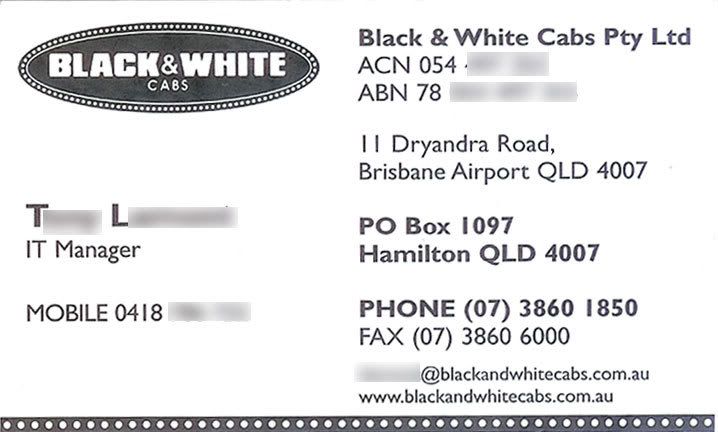
Visiting from the Land Down Under™, the designer of the card for Hamilton, Queensland's Black and White Cabs had quite a hard graft here. No fewer than five telephone numbers (we are, perhaps, incorrectly assuming the ACN and ABN digits are phone numbers), the logo, two postal addresses, email and website. To us, that's a little too much; they could have done with less; since cab customers don't often visit the cab offices, you could have done with the PO Box address only, for instance; similarly, the welter of phone numbers could have been reduced to an office/dispatch phone and the employee's mobile number. However, the designer made it work by restricting the number of fonts used to just one (the timeless Gill Sans) and leaving enough white space around the logo that, despite a diminished size, dominates the layout.
Type hierarchy is cleverly imposed with boldfacing. The recapitulation of the border of the oval at the bottom of the card is particularly charming. The designer made it work, which is admirable here.
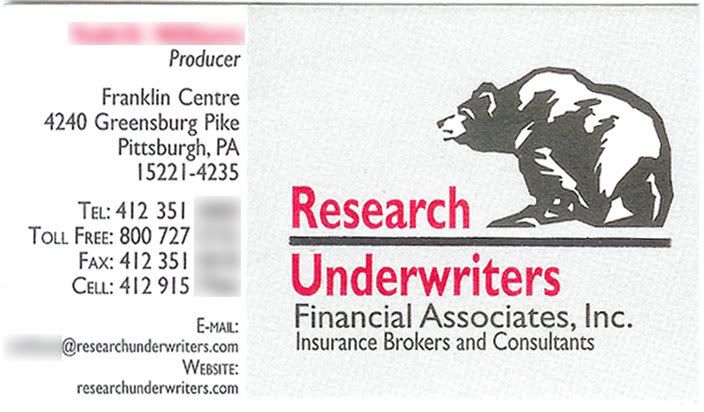
Research Underwriters' card also tries very very hard to let you know just how reachable the fellow on the card is. Four phone numbers, full postal address (including ZIP+4), email, website, and a very interesting logo (we don't know what bears and insurance brokers have in common, except perhaps the first might find the second tasty and easy to catch).
This too is a potential dog's breakfast but the desinger was very canny here. Dividing the card into two regions allows for organization and selecting a single font (Gill Sans once again) and sizing it appropriately as well as managing to get enough white space between the info blocks so it doesn't seen packed-up have slain that problem. Leaving a space between the left margin of the gray area and the left end of the logo type also creates a feeling of space. These little touches are key to keeping a very busy card readable and easy on the eyes.
What couldn't be shown in the scan is that the thick line the bear's standing on is foil ... a very classy touch.
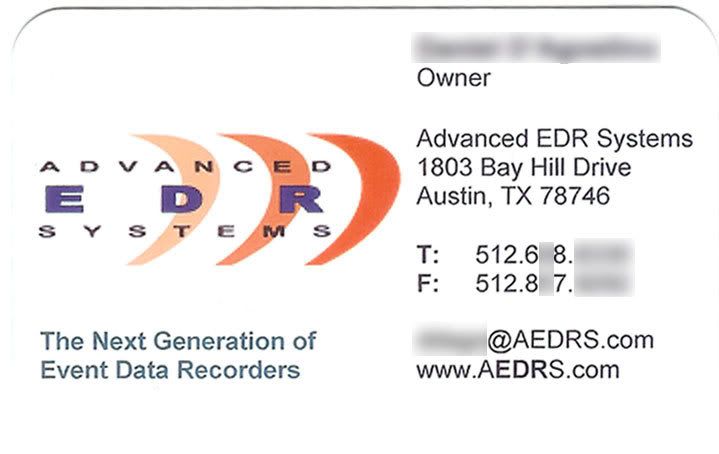
This card actually had rounded corners (as might be suggested by the shadow the scanner left along the top there). We are of two minds here; rounded corners on a card leave a positive impression, they're rather stylish, but out of a stack of cards we worry that the one with the rounded corners won't get picked out of the stack in favor of one which does have the regular corners.
The biggest flaw this card has, however, isn't layout, it's font. Arial has no business being on a business card. It's not an evil or ugly font, but it's default. Choosing Arial as your design font in applications like this is an amateur's move, and we're convinced that everyone notices this on a subliminal level – it's like wearing a wide tie to a hipster club without obvious irony. If you're tempted to use Arial, at least see if you can use actual Helvetica.
One other problem with this card is the logo. The logo isn't particularly inspired, but that's not the point. It's probably invisible at this resolution, but when we held the card in front of our peepers, it was as clear as day; the anti-aliasing was as clear as day. That's right, the designer used as small, low-res version of the company's logo. Even in my community-college classes that would have gotten me a failing grade on a project.
Layout's about that only thing that this card has going for it.
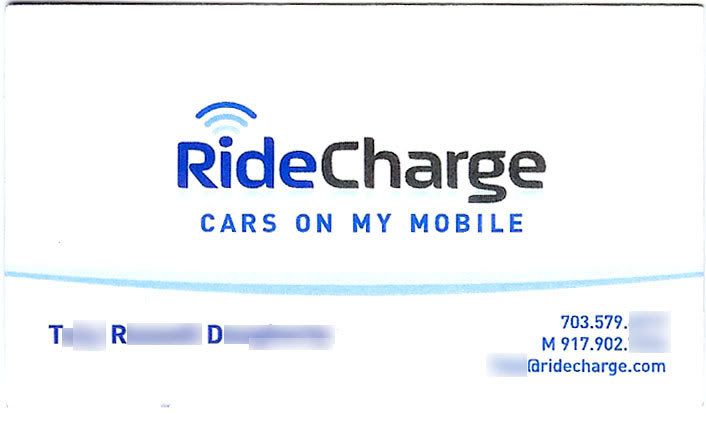
The RideCharge card, on the other hand, is sublime. I enjoy the font-smithing in the logo, which itself is a study in understatement that still communicates the company's mission (succinctly stated in the tagline). The powder-blue swoosh breaks up the white so you won't go snowblind. Two phone numbers and an email addy. Fashionable modern typeface.
Nicely done.
However, the amazing award must go to the business card of Colorado Cab:
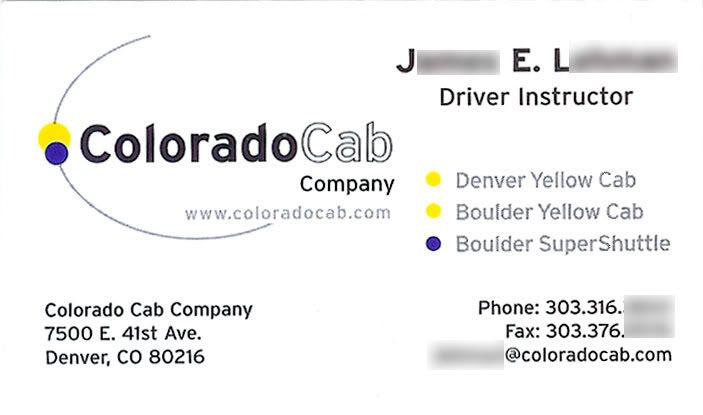
There is just one font here, one based on the familiar FHWA fontage we see on road signs. The logo is beautiful, using just two colors to connect the Colorado Cab identity to the identity of the three companies that run under its aegis (making almost-icons out of the dots). There's a lot of information here, but inspired type size and color choices leave a great amount of air in there, which means the eyes won't cross when you try to pick out individual bits of info.
I did mention the OOOOgly. The following cards earn the not-sought-after designation of Official Dog's Breakfasts:

Here's a card which can't decide if it wants to be a business card or this company's catalog on a business card. Layout seems an afterthought ... the email is in a different font than the rest of the text for no deducible reason, the rather banal tagline is surrounded by misused quotes (which can even be found on the cab top light on the right, which actually reads "It's" Taxi Time), and just in case you were too hung over to know what those pictures were, the words "TAXI STUFF" is helpfully lobbed right into the middle of it, cratering its own little space there.
That card makes me cry a little and die a little inside.
I want to leave it and the following in a room together and fight it out for ultimate baditude:
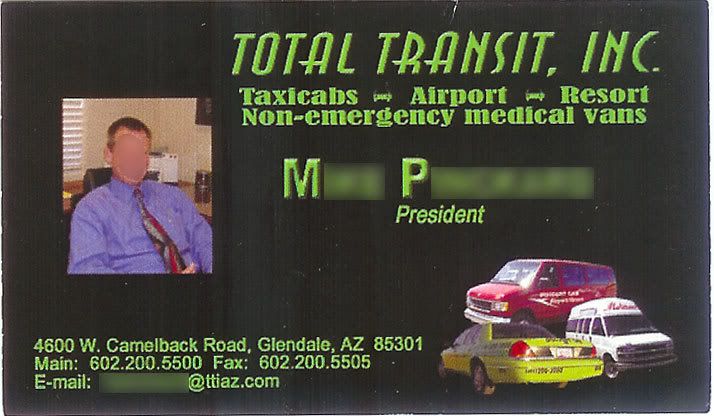
I don't know what it is about beveling/embossing type, but some people think it adds that touch of class. Three fonts on this one that just don't belong together; the artificially-italicized (we say obliqued) type above the doughy font that lists the services offered, finished up with the almost-but-not-quite-too-small Helvetica for contact information (that the black just wants to overwhelm). Color all the type a color of green that is more appropriate for halloween (or your customer's faces if your driver's style is edgy enough). Tie it all together with a photo of the card's owner and you have a heap of ugly that apparently caused a three-car pileup there in the lower right-hand corner.
Somehow, that's not the kind of message I'd want to send when I'm promoting my transportation service, but hey, as a friend has it, non gustibus disputandum. At least, that's how I think it goes. In Star Trek's classic epi "The Trouble With Tribbles", Captain Kirk had it as "there's no accounting for taste".
Well, that was fun wasn't it now? Anybody who has any OMGilicious business cards you want me to praise or criticize, send them along. I'm cranky right now, so I'd probably do a pretty good job.
Tags: business cards, business card design, snark, graphic design, type design
Powered by Qumana

No comments:
Post a Comment